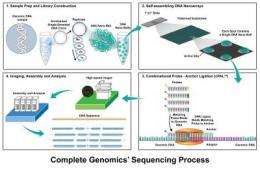Complete Genomics reports low-cost sequencing of 3 human genomes

Complete Genomics, a third-generation human genome sequencing company, today announced publication of a report in the journal Science describing its proprietary DNA sequencing platform, including analysis of sequence data from three complete human genomes. The consumables cost for these three genomes sequenced on the proof-of-principle genomic DNA nanoarrays ranged from $8,005 for 87x coverage to $1,726 for 45x coverage for the samples described in this report.
"We've demonstrated that it's possible to accurately and affordably sequence and detect variants across entire human genomes," said Cliff Reid, chairman, president and CEO of Complete Genomics. "This high-quality, cost-effective approach to genome sequencing will allow researchers to study complete genomes from hundreds of patients with a disease to advance the understanding of the genetic causes of that disease, with an end to preventing and treating common human ailments."
The manuscript, titled, "Human Genome Sequencing Using Unchained Base Reads on Self‐assembling DNA Nanoarrays," describes the methodology used to sequence cell lines derived from two individuals previously characterized by the International HapMap project. These included a Caucasian male of European descent (NA07022) and a Yoruban female (NA19240). In addition, researchers sequenced lymphoblast DNA from a Caucasian male sample (NA20431) obtained from the Personal Genome Project (PersonalGenomes.org).
Complete Genomics' proprietary platform enables efficient imaging, while requiring low reagent consumption, through its combinatorial probe anchor ligation (cPAL™) chemistry and its use of patterned genomic DNA nanoarrays. With this approach, Complete Genomics' scientists generated high-quality diploid base calls in as much as 95 percent of the genomes sequenced, identifying 3.2 million to 4.5 million sequence variants per genome processed.
![This summary table identifies variations with respect to the National Center for Biotechnology Information (NCBI) version 36 human genome reference assembly. Novel variations were ascertained by comparison to dbSNP (JDW, release 126; NA18507 [Bentley], release 128; all other genomes, release 129). NA18507 and NA19240 are Yoruban HapMap samples, which may explain the number of SNPs and novelty rates. In partially called regions of the genome, only one allele could be called confidently. The high call rate in NA19240 reflects reduced library bias with a modified sample preparation protocol. Credit: Complete Genomics, Inc.
Complete Genomics publishes in Science on low-cost sequencing of 3 human genomes](https://scx1.b-cdn.net/csz/news/800a/2009/1-completegeno.jpg)
Detailed validation of one genome dataset demonstrates a sequence accuracy of just one false variant per 100 kilobases, a remarkably low error rate, particularly for such an affordable technology.
Patterned genomic DNA nanoarrays and 70-base, unchained sequence reads are unique technical achievements. The company's new patterned genomic DNA nanoarrays, which achieve a record high density of 2.85 billion spots per slide at 0.7 micron pitch, will enable Complete Genomics to sequence 10,000 human genomes in 2010.
Source: Complete Genomics
















